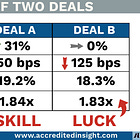Beyond the Black Box: Transparency (and Lack Thereof) in Private Markets
Stop settling for opaque
Have you ever seen a pitch deck that proudly declared:
“We pride ourselves on being opaque. Our fees are generous (and well-hidden), the waterfall has nine and a half tiers, and we commit to sending quarterly updates at least twice a year (when we feel inspired).”
No? Me neither. At least not in writing.
But let’s be honest: plenty of deals might as well come with this disclosure, even when the deck claims the GP is “transparent.”
In private markets, LPs face a wide spectrum of disclosure practices. Some GPs provide investor committee memos, full Excel models, and borrower-level credit data. Everything your due diligence heart could hope for, and then some. Others hand you a vague one-pager and expect a seven-figure commitment. Which brings me to the most important point of all —
LPs, I urge you: DEMAND BETTER TRANSPARENCY.
Yes, I’m yelling at you because as an LP, you are already playing with a massive information imbalance. If you want to make better informed decisions (as opposed to gambling, for which there are far better alternatives) — *informed* decisions assume you have actual information.
So What Does Transparency Mean?
Well, it isn’t just about sending an investor update. There are four key areas LPs should pay close attention to:
Due Diligence Transparency: what’s shared before you invest: pro formas (if possible, the Excel model), track record data, underwriting assumptions, market comparables, and business plan risks. This is where you assess whether the GP is giving you the full picture or just the broad-strokes sales pitch.
(Start here on due diligence for private equity, private credit, CRE)
Here’s how I use AI to help with due diligence:Fee and fundraising transparency: clear disclosure of the economic structure, GP commitment, and alignment of interests. This includes any joint venture partners, potential conflicts of interest, and a detailed breakdown of the capital structure.
Reporting transparency: frequency, depth, and usability of data. Does it go into property-level detail? Loan-level performance? You get the idea. Demand the full set of financial statements, and learn to read them.
Governance transparency: how decisions are made, how conflicts are handled, and how LPs are engaged. This one gets very little attention (no one sets out to have a troubled investment), but becomes critical when the proverbial stuff hits the fan.
Here’s a post on how a securities attorney would read a PPM:
Industry groups (ILPA is one of them) have worked to define best practices — for institutional LPs. There’s no equivalent body representing retail investors allocating to private markets. Arguably, this is the group that needs a strong advocate the most.
But even where institutional capital is concerned, most of the standards are voluntary. If you're CalPERS, your legal team will redline agreements and negotiate terms. The rest of us? We’re left to fend for ourselves. So let’s get into it.
Commercial Real Estate
An important caveat: the larger the AUM of the operator, the more likely they are to work with institutional capital, which makes them more likely to have buttoned up reporting. That said, opacity remains rampant in middle-market CRE.
Here’s a deeper dive on how to separate skill from luck in CRE:
What we often see:
Aggregated performance metrics with no detail into what drove returns
Sponsor-affiliated fees buried in “operating expenses”
No disclosure of preferred equity, or contingent liabilities
No cap rate/rent growth assumptions
This is a deep dive on what investors want to see in their CRE quarterly reports:
What LPs should demand before committing capital:







